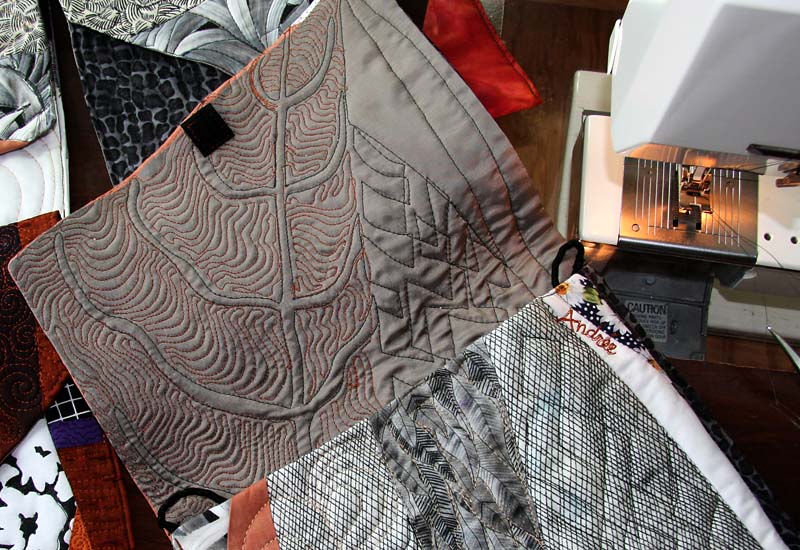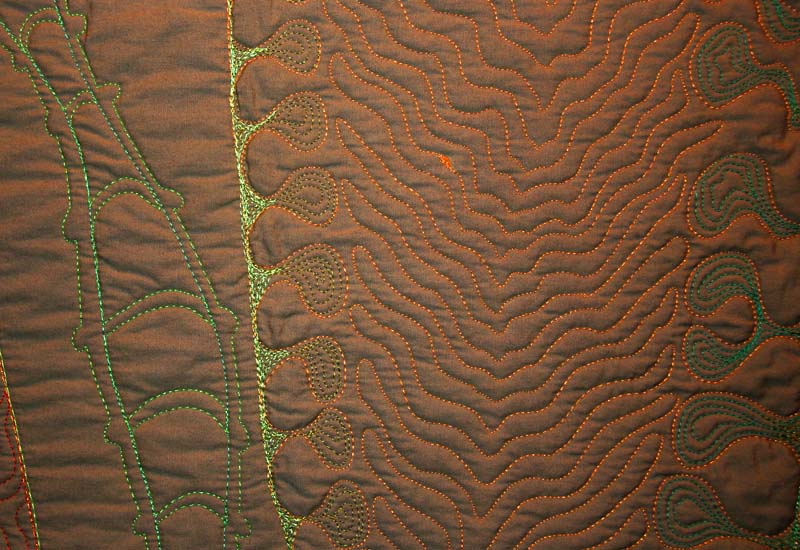Eons ago, it seems, I made a quilt that is still travelling in the Quilt National 2009 show. The collector who purchased my piece is patiently waiting for its return… later this fall.
The catalogue of the latest biennial show, Quilt National 2011, is on display at the Dairy Barn, in Ohio until September 5th. That show will then start to travel for a couple of years.
One of the artists featured is Bean Gilsdorf, whose work tackles eloquently assorted political issues, politicians, bankers, and so on.
There is a long history of quilts being used to express political opinion. Women have been far from silent, with needle and thread. In this article, Patricia Cummings gives a good background on American political quilts, going back to the 19th century.
“54-40 or Fight”
Take, for example, the Fifty-Four Forty Or Fight quilt block (link to the block pattern here, if you are interested). The block is named after one of the slogans that referred to the
“Oregon boundary dispute, or the Oregon Question, arose as a result of competing British and American claims to the Pacific Northwest of North America in the first half of the 19th century. Both the United Kingdom (UK) and the United States (USA) had territorial and commercial aspirations in the region as well as residual claims from treaties with Russia and Spain.” (From this Wikipedia page that provides a detailed description of that situation.)
In this US National Park Service page, there is a brief description of of the situation, and how war between the US and Great Britain was avoided by one wise Colonel Kearney. Otherwise, the province where I live might have been “Oregon Territory”, or simply put, in the US…
Underground Railroad Quilts
Then, there are the blocks with secret meaning that were put into quilts to quietly help illiterate slaves follow a route of escape – the Underground Railroad – from the US to Canada. This black history website from Owen Sound, Ontario, Canada, is chock-full of very interesting information. Worth exploring.
“The quilt patterns, used in a certain order, relayed messages to slaves preparing to escape. Each pattern represented a different meaning. Some of the most common were “Monkey Wrench”, “Star”, “Crossroads”, and “Wagon Wheel”. Quilts slung over a fence or windowsill, seemingly to air, passed on the necessary information to knowing slaves. As quilts hung out to air was a common sight on a plantation, neither the plantation owner nor the overseer would notice anything suspicious. It was all part of a day’s work for the slaves.” (From the Quilts page of the black history website, Owen Sound, Ontario.)
While this website goes on to explain that historians and scholars still dispute whether escaping slaves actually used these coded messages to find their way, we are reminded that there is no written proof of this “petite histoire”. It was passed down through the generations, as part of story-telling tradition.
There is also a reference to the music, songs that people sang to themselves for comfort – often gospel music. In Wade in the Water, the message refers to the flight of the Israelites from Egypt. The lyrics are “instructional”… As a treat, I’ve added a video, a clip from an Alvin Ailey classic choreography, Revelations. Enjoy!
Wade in the water,
Wade in the water children.
Wade in the water
God’s gonna trouble the water





 While I ponder how I should texture it, I will start playing with mark-making, warming up for the big piece. Above, an example of my approach to warming up: a little bag, the result of my warm up exercise… It’s a great way to loosen up, experiment and discover how to apply new patterns on quilts.
While I ponder how I should texture it, I will start playing with mark-making, warming up for the big piece. Above, an example of my approach to warming up: a little bag, the result of my warm up exercise… It’s a great way to loosen up, experiment and discover how to apply new patterns on quilts.

